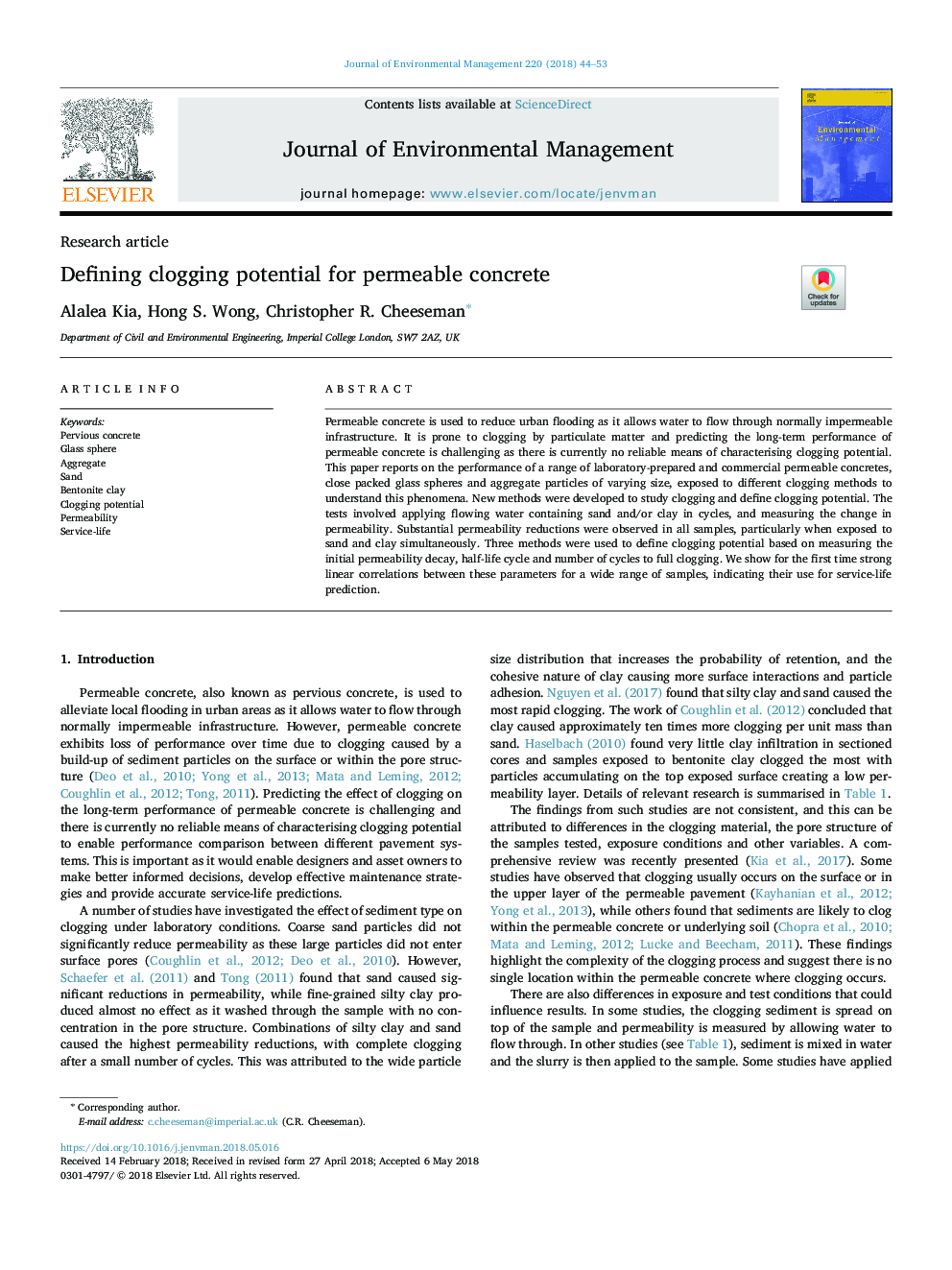| کد مقاله | کد نشریه | سال انتشار | مقاله انگلیسی | نسخه تمام متن |
|---|---|---|---|---|
| 7476405 | 1485198 | 2018 | 10 صفحه PDF | دانلود رایگان |
عنوان انگلیسی مقاله ISI
Defining clogging potential for permeable concrete
ترجمه فارسی عنوان
تعریف پتانسیل انسداد بتن نفوذپذیر
دانلود مقاله + سفارش ترجمه
دانلود مقاله ISI انگلیسی
رایگان برای ایرانیان
کلمات کلیدی
بتن پیش ساخته، کره شیشه ای، تجمیع، شن، رسوبی بنتونیت، پتانسیل انسداد، نفوذپذیری، خدمات عمر،
ترجمه چکیده
بتن قابل نفوذ برای کاهش سیل شهری استفاده می شود زیرا اجازه می دهد آب از طریق زیرساخت های غیر قابل نفوذ جریان یابد. این امر مستلزم مسدود شدن ذرات جامد می باشد و پیش بینی عملکرد بلند مدت بتن نفوذ پذیر است و چالش برانگیز است زیرا در حال حاضر ابزار قابل اعتماد برای توصیف پتانسیل مسدود شدن وجود ندارد. این مقاله بر روی عملکرد طیف وسیعی از بتن های آزمایشگاهی و تجاری قابل نفوذ، کره های شیشه ای بسته بندی شده و ذرات جامد از اندازه های مختلف، در معرض روش های مختلف اشباع برای درک این پدیده است. روش های جدید برای مطالعه مسدود شدن و تعریف پتانسیل مسدود شده توسعه داده شد. این آزمایش ها شامل استفاده از جریان آب حاوی شن و ماسه و یا رس در دوره ها و اندازه گیری تغییر در نفوذ پذیری. کاهش شدت نفوذ پذیری در تمام نمونه ها، به ویژه هنگامی که به طور همزمان در معرض شن و ماسه قرار گرفت. به منظور تعیین پتانسیل بسته شدن بر اساس اندازه گیری پراکنش نفوذپذیری اولیه، چرخه عمر نیمه عمر و تعداد چرخه ها تا مسدود شدن کامل، از سه روش استفاده شد. برای اولین بار ارتباطات خطی قوی بین این پارامترها برای طیف وسیعی از نمونه ها نشان داده شده است، نشان می دهد که استفاده از آنها برای پیش بینی عمر مفید است.
موضوعات مرتبط
مهندسی و علوم پایه
مهندسی انرژی
انرژی های تجدید پذیر، توسعه پایدار و محیط زیست
چکیده انگلیسی
Permeable concrete is used to reduce urban flooding as it allows water to flow through normally impermeable infrastructure. It is prone to clogging by particulate matter and predicting the long-term performance of permeable concrete is challenging as there is currently no reliable means of characterising clogging potential. This paper reports on the performance of a range of laboratory-prepared and commercial permeable concretes, close packed glass spheres and aggregate particles of varying size, exposed to different clogging methods to understand this phenomena. New methods were developed to study clogging and define clogging potential. The tests involved applying flowing water containing sand and/or clay in cycles, and measuring the change in permeability. Substantial permeability reductions were observed in all samples, particularly when exposed to sand and clay simultaneously. Three methods were used to define clogging potential based on measuring the initial permeability decay, half-life cycle and number of cycles to full clogging. We show for the first time strong linear correlations between these parameters for a wide range of samples, indicating their use for service-life prediction.
ناشر
Database: Elsevier - ScienceDirect (ساینس دایرکت)
Journal: Journal of Environmental Management - Volume 220, 15 August 2018, Pages 44-53
Journal: Journal of Environmental Management - Volume 220, 15 August 2018, Pages 44-53
نویسندگان
Alalea Kia, Hong S. Wong, Christopher R. Cheeseman,
